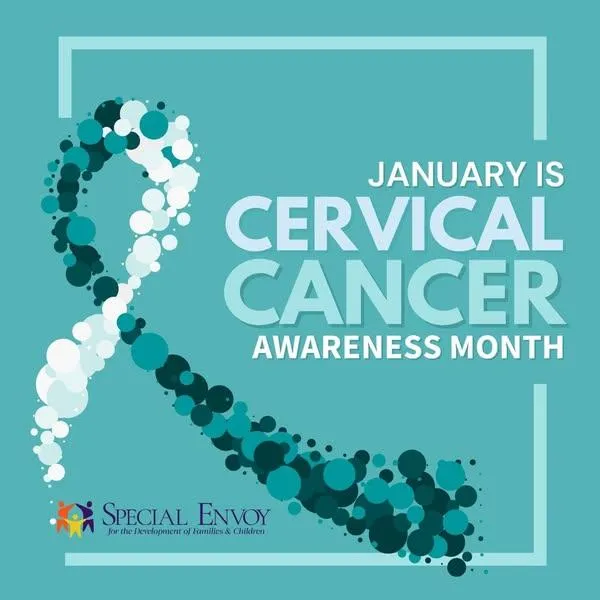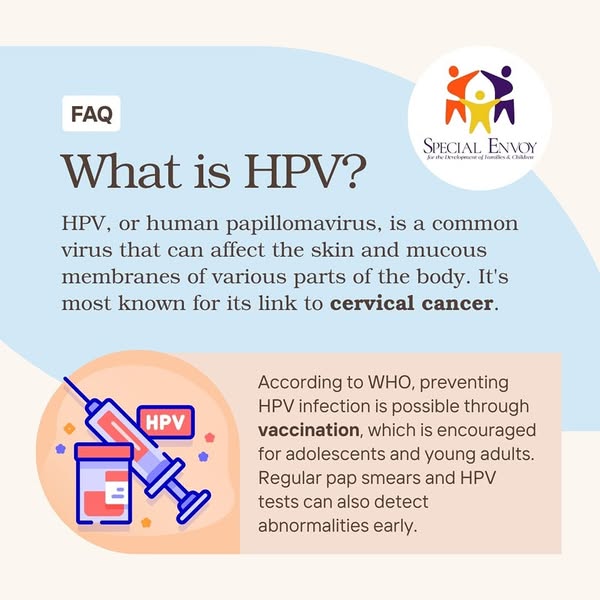Welcome to Our Blogs
INCREASE YOUR AWARENESS
Follow along as we share valuable knowledge and content to enrich and empower your everyday life.

January is Cervical Cancer Awareness Month
January is Cervical Cancer Awareness
January is Cervical Cancer Awareness Month, a time to raise awareness about a form of cancer that is both preventable and curable when detected early.
Cervical cancer is primarily caused by a persistent infection with high-risk types of the human papillomavirus (HPV), a common virus transmitted through intimate contact.
Fortunately, this type of cancer can be prevented through vaccination, regular screening, and early treatment.
The HPV vaccine is highly effective in protecting against the virus types that most often lead to cervical cancer.
Therefore, it is recommended for both boys and girls starting as early as age 9 to get one dose of the HPV vaccine.
Additionally, regular cervical cancer screening tests, such as Pap smears and HPV tests for women, are essential for detecting and treating abnormal cells before they develop into cancer.
Therefore, throughout this month and for the rest of the year, let’s prioritize health by spreading awareness about prevention and encouraging our loved ones to stay up to date with their screenings and vaccinations.
Cervical cancer is a fight we can win together through education, action, and awareness.
Together, let’s work towards a future where no woman has to face this preventable disease.
What is HPV?

Human papillomavirus (HPV) is a prevalent virus that impacts the skin and mucous membranes, affecting various areas of the body, including the genital region, mouth, and throat, in both males and females.
It stands out as the most common sexually transmitted infection (STI) and is particularly noted for its association with cervical cancer.
HPV is mainly transmitted through intimate skin-to-skin contact with an infected partner. While the use of condoms can lower the risk of transmission, it does not provide complete protection, as HPV can be spread through areas not covered by condoms.
Persistent infection with high-risk types of HPV can cause changes in cervical cells, which may increase the likelihood of developing cervical cancer over time.
To combat this risk, the World Health Organization (WHO) advocates for the HPV vaccination, especially for adolescents and young adults. This vaccine plays a crucial role in preventing HPV infection and its associated complications.
Additionally, regular screenings, such as Pap smears and HPV tests, are vital for early detection of cervical changes. These screenings can significantly reduce the risk of cervical cancer by identifying issues before they progress to more advanced stages.
In summary, prioritizing the HPV vaccine and participating in regular screenings are essential steps we can take together to pave the way toward a future free from cervical cancer.
What is Cervical Cancer Screening?

Cervical cancer screening is a simple, safe, and effective process that is designed to detect early signs of cervical cancer, offering the opportunity to treat issues before they progress.
There are two key screening tests:
Pap Test (Pap Smear): This test identifies precancerous changes in cervical cells that, if left untreated, could develop into cervical cancer.
HPV Test: This test detects the presence of high-risk human papillomavirus (HPV) types that are responsible for causing the cell changes that lead to cervical cancer.
These tests can sometimes be done simultaneously during a routine gynecological exam called "co-testing."
According to the WHO (2024), Women should be screened for cervical cancer every 5–10 years starting at age 30, while women living with HIV should be screened every 3 years starting at age 25.
The global strategy encourages a minimum of two-lifetime screens with a high-performance HPV test by age 35 and again by age 45 years.
Precancers rarely cause symptoms, which is why regular cervical cancer screening is important, even if you have been vaccinated against HPV.
By scheduling regular screenings, individuals can take charge of their health, reduce their risk of developing cervical cancer, and ensure any issues are addressed promptly.
Therefore, let’s prioritize health and encourage others to learn more about cervical cancer screening. Remember, early detection saves lives!
Cervical Cancer Symptoms

Cervical cancer may not always show symptoms, which is why regular screening is crucial for early detection. In some cases, women may experience abnormal vaginal bleeding, such as bleeding between periods, after sex, or after menopause.
Unusual vaginal discharge, which may be watery, bloody, or have a foul odor, can also be a sign of cervical cancer. Pelvic pain or pain during sex can occur, although these symptoms are not always present.
Women may also experience unexplained weight loss, fatigue, or swelling in the legs as the cancer progresses. It's important to remember that these symptoms are not exclusive to cervical cancer and can be caused by other health conditions. That’s why regular Pap tests and HPV testing are essential for early identification, even when no symptoms are present.
If detected early, cervical cancer is highly treatable, which is why staying up-to-date on screenings is critical for women’s health. So, talk to your healthcare provider about the best screening schedule for you.
Sources:
American Cancer Society. Cervical Cancer. https://www.cancer.org/cancer/types/cervical-cancer.html
Centers for Disease Control and Prevention (CDC). "Cervical Cancer Screening." https://www.cdc.gov/cervical-cancer/screening/
World Health Organization (WHO). Human Papillomavirus (HPV) and Cervical Cancer. https://www.who.int/news-room/fact-sheets/detail/human-papilloma-virus-and-cancer
National Cancer Institute. Cervical Cancer Treatment (PDQ®)–Patient Version. https://www.cancer.gov/types/cervical/treatment
Mayo Clinic. "Cervical Cancer Symptoms & Causes." https://www.mayoclinic.org/diseases-conditions/cervical-cancer/symptoms-causes/syc-20352501
@ Copyright 2025 - Special Envoy for the Development of Families & Children| All rights reserved

